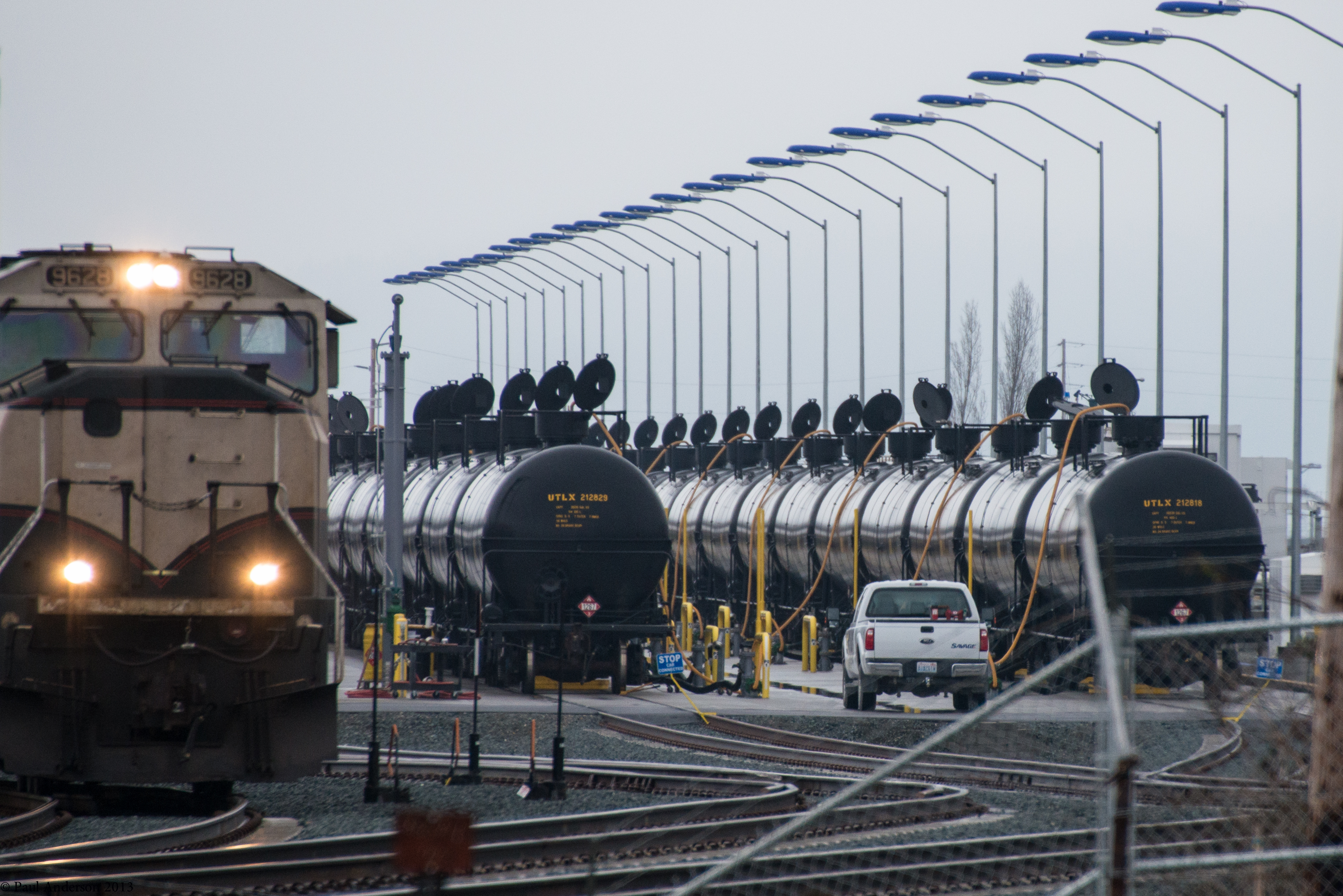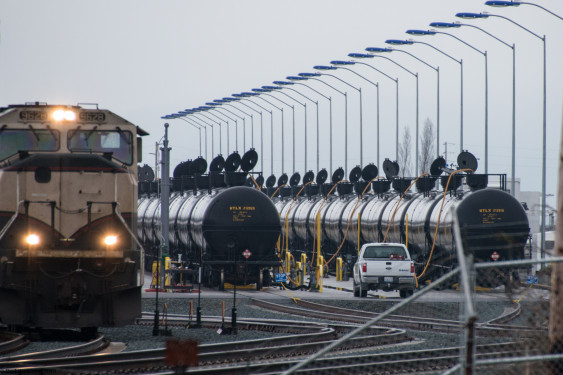Editor’s note: This article was originally published at VICE News and is republished here with permission.
The people in the Musi-Café had no idea what hit them. At about 1 a.m. on July 6, 2013, a train parked on a slope a couple miles away slipped its brakes. Seventy-two tank cars loaded with crude oil accelerated into the town of Lac-Mégantic, Quebec and began to tumble off the tracks, detonating and burning with a force so powerful that it leveled several city blocks. Forty-seven people were killed—most of whom were inside the Musi-Café.
In the months that followed, Lac-Mégantic became a rallying cry, a bloody shirt waved by activists across North America who were growing increasingly concerned about a relatively new phenomenon: ultra-long trains loaded with a peculiar variety of crude oil.
Months later, after several other oil train accidents, Warren Buffett went on CNBC claiming that oil train explosions were “very, very, very, very rare.”
If Buffett sounded defensive, it may have been because he is the single most important person in the world of oil-by-rail, an industry that he dominates and that has proven to be highly profitable for oil companies and railroads—and singularly dangerous to the public.
Depending on your definition of “rare,” Buffett’s assurances don’t appear to mesh with reality. In November 2013, an oil train in rural Alabama derailed and burst into flames that could be seen 10 miles away; the cargo eventually ended up as a smoking oil slick in a marsh.
In December 2013, an oil train struck a grain train outside Fargo, North Dakota. It spilled 400,000 gallons of crude and burst into a towering mushroom cloud. Dumbstruck drivers captured the incident on video and posted it to YouTube.
In January 2014, another train exploded in a remote part of New Brunswick.
Then in April, an oil train passing through Lynchburg, Virginia jumped off the tracks. The resulting conflagration towered above town and burned so hot that office workers on the sixth floor of a building 200 yards away reported feeling the heat. The fiery oil tankers fell into the James River. If they had instead tipped over in the direction of town, there’s no telling what could have happened.
Earlier this month, an oil train moving between rail yards in downtown Seattle derailed—but this time, the tank cars did not breach. A railroad representative said there had been no danger to the public.
Although trains in North America have moved small quantities of oil for decades, it is only in the last several years that oil trains have emerged as a high-volume delivery device—a rickety pipeline on rails.
The revolution started in the shale beneath western North Dakota, a region known as the Bakken formation. About five years ago, new fracking and horizontal drilling techniques unleashed a gusher of light crude into a region not well-served by pipelines. Railroads were quick to step into the breach, loading oil into just about any tank cars they could get their hands on, including a notorious model, the DOT-111, that federal safety investigators have been flagging as being unsafe for transporting hazardous substances for 20 years. By 2013, rail car shipments of crude were 50 or 60 times more common than they had been only a few years before, and railroads were moving the stuff to just about every corner of the continent.
Buffett’s Berkshire Hathaway is owner of the biggest player in hauling Bakken oil by rail: Burlington Northern Santa Fe Railway (BNSF). And it isn’t a minor player in Berkshire Hathaway’s impressive portfolio—BNSF was the “largest purchase in Berkshire’s history.” Last year, BNSF had revenues totaling more than $22 billion.
The company is no stranger to oil train problems. The oil train that tipped over in central Seattle was on BNSF tracks, as was the one that blew up near Fargo. Following that explosion, the Federal Railroad Administration revealed that since 2006 in the state of North Dakota alone, BNSF received 721 safety violations.
Buffett likes to maintain an avuncular and public-spirited image, but the railroad industry fights bitterly against better safety standards and often cloaks itself with intermediaries. In the regulatory arena, Berkshire-owned firms are represented by active membership in an alphabet soup of trade associations and industry lobbying groups, including the American Association of Railroads, the Railway Supply Institute, and the North American Freight Car Association.
Industry groups have opposed removing the outlet valves that protrude from the bottom of DOT-111 tank cars. Federal investigators have concluded that removing the valves would yield a “significant improvement” to tank car safety and could be “easily accomplished.” But because removing the valves would also necessitate modifying oil loading and unloading infrastructure—infrastructure the oil industry is building at a breakneck pace—the oil-by-rail industry has opposed reform.
Beleaguered by bad press about oil train explosions, in February BNSF announced plans to purchase 5,000 new, safer tank cars—though the company declined to specify a timeline for when it might actually take delivery. Just two days earlier, BNSF had lobbied the Washington State legislature to oppose a bill asking for basic disclosure about oil trains. A few weeks before that, BNSF had lobbied in opposition to union-supported safety legislation to require at least two-person crews on oil and other freight trains. The explosion in Lac-Mégantic occurred on an oil train staffed by a single crew member.
Last week, federal regulators proposed new rules that were widely heralded by the media as a victory for public safety. But in reality, the oil-by-rail industry got most of what it wanted. Even if the rules take effect—they could be amended a great deal after the current 60-day period for public comment—railroads will still be able to string together 100-car trains composed of older DOT-111 tankers for the next three years. The feds will allow bottom outlet valves, and effectively exempted short oil trains of 20 tank cars or fewer from any new regulations at all.
Buffett is rightly regarded as a legendary investor, a man who has made many enormously successful bets, including the one he made when he bought BNSF in the midst of the Great Recession. (At the time, he referred to the acquisition as an “all-in wager on the economic future of the United States.”) Now he’s betting with peoples’ lives with every oil train traveling on BNSF’s network. There is nothing stopping Buffett and the tank car industry from decommissioning the outdated tank cars, running only new or retrofitted tank cars, and eliminating bottom outlet valves.
Nothing, that is, except for the profits those measures would temporarily burn.










ron carstens
Eric, I had a chance to speak at length with Jacques Gagnon of Lac Megantic at the oil summit and he confirmed that at least 30 blocks were destroyed there.FYI This area is at least 10 times larger than the blast zone area of MOAB- America’s largest non-nuclear bomb ( nicknamed Mother Of All Bombs)The composition of MOAB is a fuel with parts per million of nanoparticles, which create easier to explode , more voluminous explosions.
The almost overnight doubling/tripling of Bakken oil was due to TWO factors, Horizontal fracking AND the extensive use of NANO MATERIALS to recover the oil. The big oil service companies put their oil development/recovery operations in a big black box bur one company FLOTEK Industries (www.flotekind.com), who is Canadian lets it all hang out because their nano-suractants sales have brought them from bankruptcy to prominence. Ck out their website in the CEIS chemicals division where they have videos of they and their customers bragging about the doubling of recovered oil flow almost overnight when they put nanosurfactants in the recovery water. This a major reason for the big Bakken flow (and they extend well life). These very materials residual in the oil put into tankcars are,I believe, are the chief culprit for the abmormally explosive nature of it. My company made and sold nanomaterials for over 20 years so I speak with some veracity about the quantum nature of these
materials. It’s axiomatic in the explosive industry that smaller particles make bigger explosions. Nano particles have over a million times more surface area than the ordinary size particles we are used to. Recently, researchers have concluded the best way to make lots of cheap buckyballs and carbon nano-tubes et al are by exploding a hydrocarbon Which is why the Bakken explosions photos always show a blossoming, mushrooming character as each explosion produces yet more nanoparticles to fuel the next bigger explosion. Food for thought. Ron Carstens MSChE